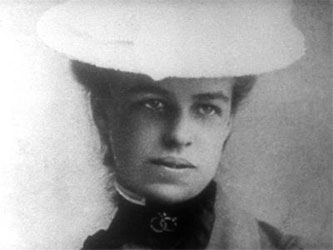|
J. William T. "Bill" Youngs, Eleanor Roosevelt: A Personal and Public Life, Chapter Three
|
"Portrait of Young Eleanor Roosevelt" courtesy of the National Archives
|
Mlle. Souvestre shocked me into thinking, and that on the whole was very beneficial.
- Eleanor Roosevelt, This is My Story
- Eleanor Roosevelt, This is My Story
Author reads from the Text
She Realized, of course, that not everyone was wealthy. In her idyllic realm, however, even the poor seemed content to respect and serve the rich. they were friendly servants in her grandmother's kitchen, a nice colored peddler who sold his wares on the train, and the slum children who were so appreciative when she and her aunts and uncles gave them Christmas presents and sang them carols. Eleanor probably never stopped to wonder whether these people ever longed for smart carriages and country estates of their own, or why she had received such treasures and they had not. She knew only the world as it was.
One day, then she was about twelve, she glimpsed another world, where people were poor and desperate. She was riding in a horse-drawn stage with her governess. Suddenly a wretched-looking man jumped on the car and tried to snatch the purse form a woman nearby. Failing, he jumped back to the street and ran through the crowd followed by shouts of "stop thief." Eleanor was so shocked she jumped out of the moving stage and stood dumbfounded in the street until her maid came running and scolding after her. She got back in the car and went on to her French lesson; but all that day and for months to come she was disturbed by "the face of that poor, haunted man."
That face had no place in Eleanor's childhood domain. She would not really understand the man's desperation until two decades later when her own world collapsed around her.
One day, then she was about twelve, she glimpsed another world, where people were poor and desperate. She was riding in a horse-drawn stage with her governess. Suddenly a wretched-looking man jumped on the car and tried to snatch the purse form a woman nearby. Failing, he jumped back to the street and ran through the crowd followed by shouts of "stop thief." Eleanor was so shocked she jumped out of the moving stage and stood dumbfounded in the street until her maid came running and scolding after her. She got back in the car and went on to her French lesson; but all that day and for months to come she was disturbed by "the face of that poor, haunted man."
That face had no place in Eleanor's childhood domain. She would not really understand the man's desperation until two decades later when her own world collapsed around her.

